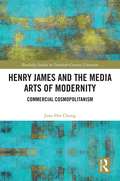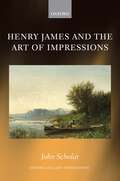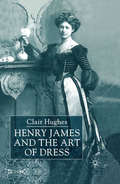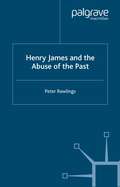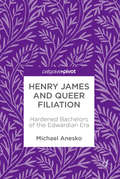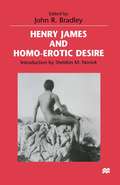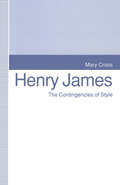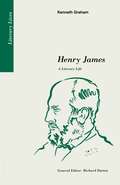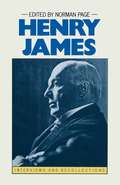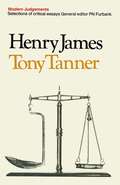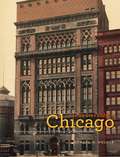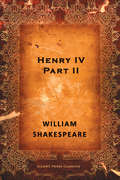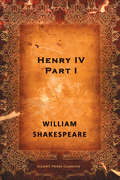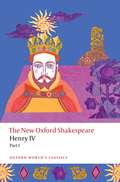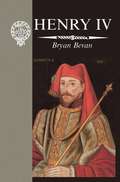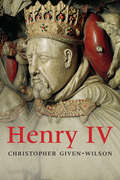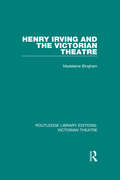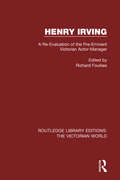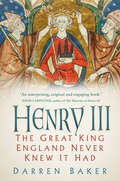- Table View
- List View
Henry James and the Media Arts of Modernity: Commercial Cosmopolitanism (Routledge Studies in Twentieth-Century Literature)
by June Hee ChungHenry James and the Media Arts of Modernity: Commercial Cosmopolitanism turns to the author’s late fiction, letters, and essays to investigate his contribution to the development of an American cosmopolitan culture, both in popular and high art. The book contextualizes James’s writing within a broader cultural and social history to uncover relationships among increasingly sensory-focused media technologies, mass-consumer practices, and developments in literary style when they spread to Europe at the inception of the era of big business. Combining cultural studies with neoclassical Marxism and postcolonial theory, the study addresses a gap in scholarship concerning the rise of literary modernism as a cosmopolitan phenomenon. Although scholars have traditionally acknowledged the international character of artists’ participation in this movement, when analyzing the contributions of American expatriate writers in Europe, they generally assume an unequal degree of reciprocity in transatlantic cultural exchange with European artists being more influential than American ones. This book argues that James identifies a cultural form of American imperialism that emerged out of a commercialized version of cosmopolitanism. Yet the author appropriates the arts of modernity when he realizes that art generated with the mechanized principles of mass-production spurred a diverse range of aesthetic responses to other early-twentieth century technological and organizational innovations.
Henry James and the Art of Impressions (Oxford English Monographs)
by John ScholarHenry James criticized the impressionism that was revolutionizing French painting and fiction. He satirized the British aesthetic movement whose keystone was impressionist criticism. So why, time and again in important parts of his literary work, did James use the word 'impression'? Henry James and the Art of Impressions argues that James tried to wrest the impression from the impressionists and to recast it in his own art of the novel. Interdisciplinary in its range, philosophical and literary in its focus, the book shows the place of James's work within the wider cultural history of impressionism. It draws on painting, philosophy, psychology, literature, and critical theory to examine James's art criticism, early literary criticism, travel writing, reflections on his own fiction, and the three great novels of his major phase, The Ambassadors, The Wings of the Dove, and The Golden Bowl. It shows how the language of impressions enables James to represent the most intense moments of consciousness of his characters. It argues that the Jamesian impression is best understood as a family of related ideas bound together by James's attempt to reconcile the novel's value as a mimetic form with its value as a transformative creative activity.
Henry James and the Art of Impressions (Oxford English Monographs)
by John ScholarHenry James criticized the impressionism that was revolutionizing French painting and fiction. He satirized the British aesthetic movement whose keystone was impressionist criticism. So why, time and again in important parts of his literary work, did James use the word 'impression'? Henry James and the Art of Impressions argues that James tried to wrest the impression from the impressionists and to recast it in his own art of the novel. Interdisciplinary in its range, philosophical and literary in its focus, the book shows the place of James's work within the wider cultural history of impressionism. It draws on painting, philosophy, psychology, literature, and critical theory to examine James's art criticism, early literary criticism, travel writing, reflections on his own fiction, and the three great novels of his major phase, The Ambassadors, The Wings of the Dove, and The Golden Bowl. It shows how the language of impressions enables James to represent the most intense moments of consciousness of his characters. It argues that the Jamesian impression is best understood as a family of related ideas bound together by James's attempt to reconcile the novel's value as a mimetic form with its value as a transformative creative activity.
Henry James and the Art of Dress
by C. HughesHenry James was fascinated by clothing and dress. This book examines, for the first time, the role of dress in reinforcing thematic and symbolic patterns in James's fictional world. Hughes traces a development from the significance of dress in discussion of 'the American Girl' in the early works, through dress as an indicator of social position, to the emergence of the more unstable and threatening aspects of dress, which culminate in the strange case of the coat of changing colours in The Sense of the Past.
Henry James and the Abuse of the Past
by P. RawlingsHenry James and the Abuse of the Past explores the complex uses to which James puts his oblique experience of the American Civil War. Why does James use and abuse the past by fabricating and distorting people and events in his autobiographical work? The study integrates four elements: history, the past and problems of narration and representation; the homoerotics of the Civil war tales and other soldiering fiction; a life-long pre-occupation with Shakespeare as a historical figure; and theories of time as they come under the pressure of trauma and war. This well-written, insightful and persuasive study is an important contribution to James scholarship and will be of interest to any students and scholars of James
Henry James and Queer Filiation: Hardened Bachelors of the Edwardian Era
by Michael AneskoThis study challenges the notion that closeted secrecy was a necessary part of social life for gay men living in the shadow of the trial and imprisonment of Oscar Wilde. It reconstructs a surprisingly open network of queer filiation in which Henry James occupied a central place. The lives of its satellite figures — most now forgotten or unknown — offer even more suggestive evidence of some of the countervailing forms of social practice that could survive even in that hostile era. If these men enjoyed such exemption largely because of the prerogatives of class privilege, their relative freedom was nevertheless a visible rebuke to the reductive stereotypes of homosexuality that circulated and were reinforced in the culture of the period. This book will be of particular interest to scholars of Henry James and queer studies, readers of late Victorian and modern literature, and those interested in the history and social construction of gender roles.
Henry James and Queer Filiation: Hardened Bachelors of the Edwardian Era
by Michael AneskoThis study challenges the notion that closeted secrecy was a necessary part of social life for gay men living in the shadow of the trial and imprisonment of Oscar Wilde. It reconstructs a surprisingly open network of queer filiation in which Henry James occupied a central place. The lives of its satellite figures — most now forgotten or unknown — offer even more suggestive evidence of some of the countervailing forms of social practice that could survive even in that hostile era. If these men enjoyed such exemption largely because of the prerogatives of class privilege, their relative freedom was nevertheless a visible rebuke to the reductive stereotypes of homosexuality that circulated and were reinforced in the culture of the period. This book will be of particular interest to scholars of Henry James and queer studies, readers of late Victorian and modern literature, and those interested in the history and social construction of gender roles.
Henry James and Homo-Erotic Desire
by John BradleySheldon M. Novick has written an extensive biographical introduction. This is complimented by an essay documenting James's friendships with younger men, which includes quotations from unpublished letters. Other subjects include the influence on James of the emergence of a specific concept of 'the homosexual' and James's reactions to the aesthetic movement; and there are close analyses of many of James's stories and novels, selected so that all of his career is represented.
Henry James: A Literary Life (Literary Lives)
by Kenneth GrahamThis comprehensive account of the writing life of Henry James aims at providing a critical overview of all his important writings, firmly set in two contexts: that of James's practical career as a novelist in America, England, and Europe; and that of the literary and intellectual climate of his time. By tracing the complex development of his career under such headings as 'American and Romantic', 'Victorian and Realist', 'Crisis and Experiment' and 'Master and Modernist', it gives a dynamic portrait, both factual and interpretative, of one of the greatest and most prolific novelists in the language, whose many-sided career began in the time of Thackeray and Dickens, and ended by ushering in the writings of Joyce and Woolf.
Henry Ives Cobb's Chicago: Architecture, Institutions, and the Making of a Modern Metropolis (Chicago Architecture and Urbanism)
by Edward W. WolnerWhen championing the commercial buildings and homes that made the Windy City famous, one can’t help but mention the brilliant names of their architects—Daniel Burnham, Louis Sullivan, and Frank Lloyd Wright, among others. But few people are aware of Henry Ives Cobb (1859–1931), the man responsible for an extraordinarily rich chapter in the city’s turn-of-the-century building boom, and fewer still realize Cobb’s lasting importance as a designer of the private and public institutions that continue to enrich Chicago’s exceptional architectural heritage. Henry Ives Cobb’s Chicago is the first book about this distinguished architect and the magnificent buildings he created, including the Newberry Library, the Chicago Historical Society, the Chicago Athletic Association, the Fisheries Building for the 1893 World’s Fair, and the Chicago Federal Building. Cobb filled a huge institutional void with his inventive Romanesque and Gothic buildings—something that the other architect-giants, occupied largely with residential and commercial work, did not do. Edward W. Wolner argues that these constructions and the enterprises they housed—including the first buildings and master plan for the University of Chicago—signaled that the city had come of age, that its leaders were finally pursuing the highest ambitions in the realms of culture and intellect. Assembling a cast of colorful characters from a free-wheeling age gone by, and including over 140 images of Cobb’s most creative buildings, Henry Ives Cobb’s Chicago is a rare achievement: a dynamic portrait of an architect whose institutional designs decisively changed the city’s identity during its most critical phase of development.
Henry Ives Cobb's Chicago: Architecture, Institutions, and the Making of a Modern Metropolis (Chicago Architecture and Urbanism)
by Edward W. WolnerWhen championing the commercial buildings and homes that made the Windy City famous, one can’t help but mention the brilliant names of their architects—Daniel Burnham, Louis Sullivan, and Frank Lloyd Wright, among others. But few people are aware of Henry Ives Cobb (1859–1931), the man responsible for an extraordinarily rich chapter in the city’s turn-of-the-century building boom, and fewer still realize Cobb’s lasting importance as a designer of the private and public institutions that continue to enrich Chicago’s exceptional architectural heritage. Henry Ives Cobb’s Chicago is the first book about this distinguished architect and the magnificent buildings he created, including the Newberry Library, the Chicago Historical Society, the Chicago Athletic Association, the Fisheries Building for the 1893 World’s Fair, and the Chicago Federal Building. Cobb filled a huge institutional void with his inventive Romanesque and Gothic buildings—something that the other architect-giants, occupied largely with residential and commercial work, did not do. Edward W. Wolner argues that these constructions and the enterprises they housed—including the first buildings and master plan for the University of Chicago—signaled that the city had come of age, that its leaders were finally pursuing the highest ambitions in the realms of culture and intellect. Assembling a cast of colorful characters from a free-wheeling age gone by, and including over 140 images of Cobb’s most creative buildings, Henry Ives Cobb’s Chicago is a rare achievement: a dynamic portrait of an architect whose institutional designs decisively changed the city’s identity during its most critical phase of development.
Henry IV, Part II: A History
by William ShakespeareAfter defeat at the Battle of Shrewsbury the rebels regroup. But Prince Hal’s reluctance to inherit the crown threatens to destroy the ailing Henry IV’s dream of a lasting dynasty. Shakespeare’s portrait of the prodigal son’s journey from youth to maturity embraces the full panorama of society. Henry IV, Part 2 is believed to have been written between 1596 and 1599. It is the third part of a tetralogy, preceded by Richard II and Henry IV, Part 1 and succeeded by Henry V.
Henry IV, Part I: A History
by William ShakespeareAfter overthrowing his predecessor, King Henry IV is acutely aware of the delicate political tensions he must balance to protect his throne. On one hand, he must rein in his son, the mischievous Prince Hal, who has left the court for a life of drinking and pleasure. At the same time, he must put down a rebellion of some of the most powerful families in England. Henry IV, Part I is the second of four connected plays about successive British monarchs, including Richard II, Henry IV, Part II, and Henry V.
Henry IV Part I: The New Oxford Shakespeare (Oxford World's Classics)
by William Shakespeare'What is honour? A word. What is in that word 'honour'? What is that 'honour'? Air.' A history play that combines a coming-of-age narrative with a tale of power, rebellion, friendship, and betrayal, Henry IV, Part I has been a perennial favourite from Shakespeare's time to the present. What has ensured its popularity is above all the towering figure of Falstaff, Shakespeare's greatest comic creation. The ebullient, unabashedly pleasure-seeking and brilliantly witty character has proved as irresistible for audiences as he was for his protégé, Prince Hal. This introduction discusses their relationship within the framework of the play's historical, cultural, and performative setting. At the same time, it explores the question of why the play has proved so enduringly attractive to audiences today. The New Oxford Shakespeare offers authoritative editions of Shakespeare's works with introductory materials designed to encourage new interpretations of the plays and poems. Using the text from the landmark The New Oxford Shakespeare Complete Works: Modern Critical Edition, these volumes offer readers the latest thinking on the authentic texts (collated from all surviving original versions of Shakespeare's work) alongside innovative introductions from leading scholars. The texts are accompanied by a comprehensive set of critical apparatus to give readers the best resources to help understand and enjoy Shakespeare's work. ABOUT THE SERIES: For over 100 years Oxford World's Classics has made available the widest range of literature from around the globe. Each affordable volume reflects Oxford's commitment to scholarship, providing the most accurate text plus a wealth of other valuable features, including expert introductions by leading authorities, helpful notes to clarify the text, up-to-date bibliographies for further study, and much more.
Henry IV Part I: The New Oxford Shakespeare (Oxford World's Classics)
by William Shakespeare'What is honour? A word. What is in that word 'honour'? What is that 'honour'? Air.' A history play that combines a coming-of-age narrative with a tale of power, rebellion, friendship, and betrayal, Henry IV, Part I has been a perennial favourite from Shakespeare's time to the present. What has ensured its popularity is above all the towering figure of Falstaff, Shakespeare's greatest comic creation. The ebullient, unabashedly pleasure-seeking and brilliantly witty character has proved as irresistible for audiences as he was for his protégé, Prince Hal. This introduction discusses their relationship within the framework of the play's historical, cultural, and performative setting. At the same time, it explores the question of why the play has proved so enduringly attractive to audiences today. The New Oxford Shakespeare offers authoritative editions of Shakespeare's works with introductory materials designed to encourage new interpretations of the plays and poems. Using the text from the landmark The New Oxford Shakespeare Complete Works: Modern Critical Edition, these volumes offer readers the latest thinking on the authentic texts (collated from all surviving original versions of Shakespeare's work) alongside innovative introductions from leading scholars. The texts are accompanied by a comprehensive set of critical apparatus to give readers the best resources to help understand and enjoy Shakespeare's work. ABOUT THE SERIES: For over 100 years Oxford World's Classics has made available the widest range of literature from around the globe. Each affordable volume reflects Oxford's commitment to scholarship, providing the most accurate text plus a wealth of other valuable features, including expert introductions by leading authorities, helpful notes to clarify the text, up-to-date bibliographies for further study, and much more.
Henry IV
by B. BevanHenry of Bolingbroke was one of the most important noblemen of the later fourteenth century. Brave, chivalrous and cultured, a talented musician, he excelled at the jousts held at his cousin Richard II's Court, acquiring military experience at Radcot Bridge in Oxfordshire and later fighting with the Teutonic Knights in Prussia. A great medieval traveller, he visited Konigsberg as Earl of Derby, travelling to Danzig, Prague and later Venice and Jerusalem. Bitterly opposed to Richard II's favourites, Bolingbroke as one of the Lords Appellant played a vital part. Henry's most controversial actions were the deposition of Richard II (1399) and the execution of Richard Scrope, Archbishop of York, after he had usurped Richard's throne. As Henry IV, an usurper, the King knew little peace, incessantly engrossed as he was in preserving his throne; and the French and Scots never allowed him to forget his usurpation. For many years he fought a savage and frustrating war against the great Welsh rebel Owain Glyn Dwr, but defeated the immortal Harry Percy (Hotspur) at the Battle of Shrewsbury (1403). In his relations with his Parliaments, Henry showed acumen and praiseworthy restraint, unlike his predecessor who was determined to be an absolute King. His short reign was remarkable for the development of Parliament.
Henry IV: Henry Iv, 1399-1413 (The English Monarchs Series)
by Chris Given-WilsonHenry IV (1399–1413), the son of John of Gaunt, duke of Lancaster, seized the English throne at the age of thirty-two from his cousin Richard II and held it until his death, aged forty-five, when he was succeeded by his son, Henry V. This comprehensive and nuanced biography restores to his rightful place a king often overlooked in favor of his illustrious progeny. Henry faced the usual problems of usurpers: foreign wars, rebellions, and plots, as well as the ambitions and demands of the Lancastrian retainers who had helped him win the throne. By 1406 his rule was broadly established, and although he became ill shortly after this and never fully recovered, he retained ultimate power until his death. Using a wide variety of previously untapped archival materials, Chris Given-Wilson reveals a cultured, extravagant, and skeptical monarch who crushed opposition ruthlessly but never quite succeeded in satisfying the expectations of his own supporters.
Henry Irving and The Victorian Theatre (Routledge Library Editions: Victorian Theatre)
by Madeleine BinghamOriginally published in 1978. Henry Irving achieved an astounding success in Britain and America as an actor; yet he lacked good looks, had spindly legs, and did not have a good voice. He said so himself. Today Irving is regarded as the archetype of the old-time actor, but in his own time he was regarded as a great theatrical innovator. Even Bernard Shaw, who attacked him pitilessly, even unto death, called him ‘modern’ when he first saw him act. Irving, the man, with his tenacious, obsessive talent, his human limitations and weaknesses, and his ephemeral glory is brought most sympathetically to life in this biography. It is written from contemporary sources, and from criticisms, lampoons, caricatures and gossip columns. If Irving reflected certain aspects of his age, this book underlines the Victorian ethic to which he appealed and the backcloths against which it was set – the extraordinary lavishness of the Lyceum productions and the incredible extravagance of social entertaining. Not the least absorbing aspect of this biography is the fascinating account of the long partnership between Irving and Ellen Terry, still in many respects an enigmatic one, but here portrayed with lively insight into character combined with understanding and deep knowledge of the social and theatrical context of the Victorian age.
Henry Irving and The Victorian Theatre (Routledge Library Editions: Victorian Theatre)
by Madeleine BinghamOriginally published in 1978. Henry Irving achieved an astounding success in Britain and America as an actor; yet he lacked good looks, had spindly legs, and did not have a good voice. He said so himself. Today Irving is regarded as the archetype of the old-time actor, but in his own time he was regarded as a great theatrical innovator. Even Bernard Shaw, who attacked him pitilessly, even unto death, called him ‘modern’ when he first saw him act. Irving, the man, with his tenacious, obsessive talent, his human limitations and weaknesses, and his ephemeral glory is brought most sympathetically to life in this biography. It is written from contemporary sources, and from criticisms, lampoons, caricatures and gossip columns. If Irving reflected certain aspects of his age, this book underlines the Victorian ethic to which he appealed and the backcloths against which it was set – the extraordinary lavishness of the Lyceum productions and the incredible extravagance of social entertaining. Not the least absorbing aspect of this biography is the fascinating account of the long partnership between Irving and Ellen Terry, still in many respects an enigmatic one, but here portrayed with lively insight into character combined with understanding and deep knowledge of the social and theatrical context of the Victorian age.
Henry Irving: A Re-Evaluation of the Pre-Eminent Victorian Actor-Manager (Routledge Library Editions: The Victorian World)
by Richard FoulkesHenry Irving (1838-1905), the first actor to be knighted, dominated the theatre in Britain and beyond for over a quarter of a century. As an actor, he was strikingly different with his idiosyncratic pronunciation, his somewhat ungainly physique, and his brilliant psychological portrayals of virtue and villainy. He was also the director of spectacular, and commercially driven, entertainments and as the manager of the Lyceum theatre, he controlled every aspect of the performance. First published in 2008, this collection of essays by leading theatre scholars explores each element of Irving’s art: his acting, his contribution to the plays he commissioned, his flair for the stage picture, and his ear for incidental music. This book will be of interest to those studying the history of theatre.
Henry Irving: A Re-Evaluation of the Pre-Eminent Victorian Actor-Manager (Routledge Library Editions: The Victorian World)
by Richard FoulkesHenry Irving (1838-1905), the first actor to be knighted, dominated the theatre in Britain and beyond for over a quarter of a century. As an actor, he was strikingly different with his idiosyncratic pronunciation, his somewhat ungainly physique, and his brilliant psychological portrayals of virtue and villainy. He was also the director of spectacular, and commercially driven, entertainments and as the manager of the Lyceum theatre, he controlled every aspect of the performance. First published in 2008, this collection of essays by leading theatre scholars explores each element of Irving’s art: his acting, his contribution to the plays he commissioned, his flair for the stage picture, and his ear for incidental music. This book will be of interest to those studying the history of theatre.
Henry III: The Great King England Never Knew It Had
by Darren BakerHenry III (1207–72) reigned for 56 years, the longest-serving English monarch until the modern era. Although knighted by William Marshal, he was no warrior king like his uncle Richard the Lionheart. He preferred to feed the poor to making war and would rather spend time with his wife and children than dally with mistresses and lord over roundtables. He sought to replace the dull projection of power imported by his Norman predecessors with a more humane and open-hearted monarchy. But his ambition led him to embark on bold foreign policy initiatives to win back the lands and prestige lost by his father King John. This set him at odds with his increasingly insular barons and clergy, now emboldened by the protections of Magna Carta. In one of the great political duels of history, Henry struggled to retain the power and authority of the crown against radical reformers like Simon de Montfort. He emerged victorious, but at a cost both to the kingdom and his reputation among historians. Yet his long rule also saw extraordinary advancements in politics and the arts, from the rise of the parliamentary state and universities to the great cathedrals of the land, including Henry’s own enduring achievement, Westminster Abbey.
